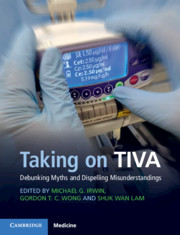16 results
The Hierarchical Taxonomy of Psychopathology (HiTOP) in psychiatric practice and research
-
- Journal:
- Psychological Medicine / Volume 52 / Issue 9 / July 2022
- Published online by Cambridge University Press:
- 02 June 2022, pp. 1666-1678
-
- Article
- Export citation
Chapter 3 - TCI and TIVA: What a Good Idea!
-
-
- Book:
- Taking on TIVA
- Published online:
- 18 November 2019
- Print publication:
- 05 December 2019, pp 14-21
-
- Chapter
- Export citation
Chapter 8 - ‘But I’m Used to MAC!’
-
-
- Book:
- Taking on TIVA
- Published online:
- 18 November 2019
- Print publication:
- 05 December 2019, pp 52-62
-
- Chapter
- Export citation
Chapter 13 - Under Pressure
-
-
- Book:
- Taking on TIVA
- Published online:
- 18 November 2019
- Print publication:
- 05 December 2019, pp 106-110
-
- Chapter
- Export citation
Foreword
-
- Book:
- Taking on TIVA
- Published online:
- 18 November 2019
- Print publication:
- 05 December 2019, pp ix-ix
-
- Chapter
- Export citation
Chapter 20 - Skiing Off-Piste and Other Assorted Goodies
-
-
- Book:
- Taking on TIVA
- Published online:
- 18 November 2019
- Print publication:
- 05 December 2019, pp 162-169
-
- Chapter
- Export citation
Chapter 6 - Let’s Get Started
-
-
- Book:
- Taking on TIVA
- Published online:
- 18 November 2019
- Print publication:
- 05 December 2019, pp 40-45
-
- Chapter
- Export citation
Index
-
- Book:
- Taking on TIVA
- Published online:
- 18 November 2019
- Print publication:
- 05 December 2019, pp 170-176
-
- Chapter
- Export citation
Contents
-
- Book:
- Taking on TIVA
- Published online:
- 18 November 2019
- Print publication:
- 05 December 2019, pp v-vi
-
- Chapter
- Export citation
Chapter 1 - Why Bother?
-
-
- Book:
- Taking on TIVA
- Published online:
- 18 November 2019
- Print publication:
- 05 December 2019, pp 1-4
-
- Chapter
- Export citation
Copyright page
-
- Book:
- Taking on TIVA
- Published online:
- 18 November 2019
- Print publication:
- 05 December 2019, pp iv-iv
-
- Chapter
- Export citation
Power to the People: the Rationale of a Practical Text
-
-
- Book:
- Taking on TIVA
- Published online:
- 18 November 2019
- Print publication:
- 05 December 2019, pp x-x
-
- Chapter
- Export citation
Chapter 2 - You Say ‘PK’ and I Say ‘No Way!’; You Say ‘Keo’ and I Say ‘Time to Go!’
-
-
- Book:
- Taking on TIVA
- Published online:
- 18 November 2019
- Print publication:
- 05 December 2019, pp 5-13
-
- Chapter
- Export citation
Contributors
-
- Book:
- Taking on TIVA
- Published online:
- 18 November 2019
- Print publication:
- 05 December 2019, pp vii-viii
-
- Chapter
- Export citation

Taking on TIVA
- Debunking Myths and Dispelling Misunderstandings
-
- Published online:
- 18 November 2019
- Print publication:
- 05 December 2019
Contributors
-
-
- Book:
- The Cambridge Handbook of Personal Relationships
- Published online:
- 05 June 2012
- Print publication:
- 05 June 2006, pp xvii-xxii
-
- Chapter
- Export citation



